
If you’re tired of traditional sit-ups and crunches, discover a new type of exercise that simultaneously engages multiple muscle groups. This article will explore compound ab exercises that sculpt your abs, enhance functional strength, and promote overall fitness. Plus, you can amplify your results with a potent fat burner.
This winning combination of focused ab exercises, a balanced diet, and high-quality supplements will maximize the effectiveness of your routine and promote muscle-building. Get ready to transform your core and take your fitness journey to a new level!
Best Compound Core Exercises For Ab
Here is a list of compound ab exercises to help strengthen your core to improve stability and functional strength:
- Hanging Leg Raises.
- Medicine Ball Slams.
- Ab Wheel Rollouts.
- Plank With Arm Raises.
- Renegade Rows.
- Woodchoppers.
- Single-Arm Kettlebell Swing.
Best Compound Ab Exercises For Abdominal Strength
Compound ab exercises are a powerful way to strengthen and tone your core while engaging other muscle groups for a more comprehensive workout. Here are seven of the best compound exercises and their benefits.
Hanging Leg Raise
Hanging leg raise exercises target the lower abdominal muscles and hip flexors while engaging your shoulders and grip strength. To perform this exercise, hang from a pull-up bar with an overhand grip, and then raise your legs as high as you can while keeping them straight.
This exercise helps build a strong and defined midsection, improves core stability, and enhances overall body control. It’s an excellent addition to any core workout routine and can contribute to better posture, increased athletic performance, and a more sculpted midsection.
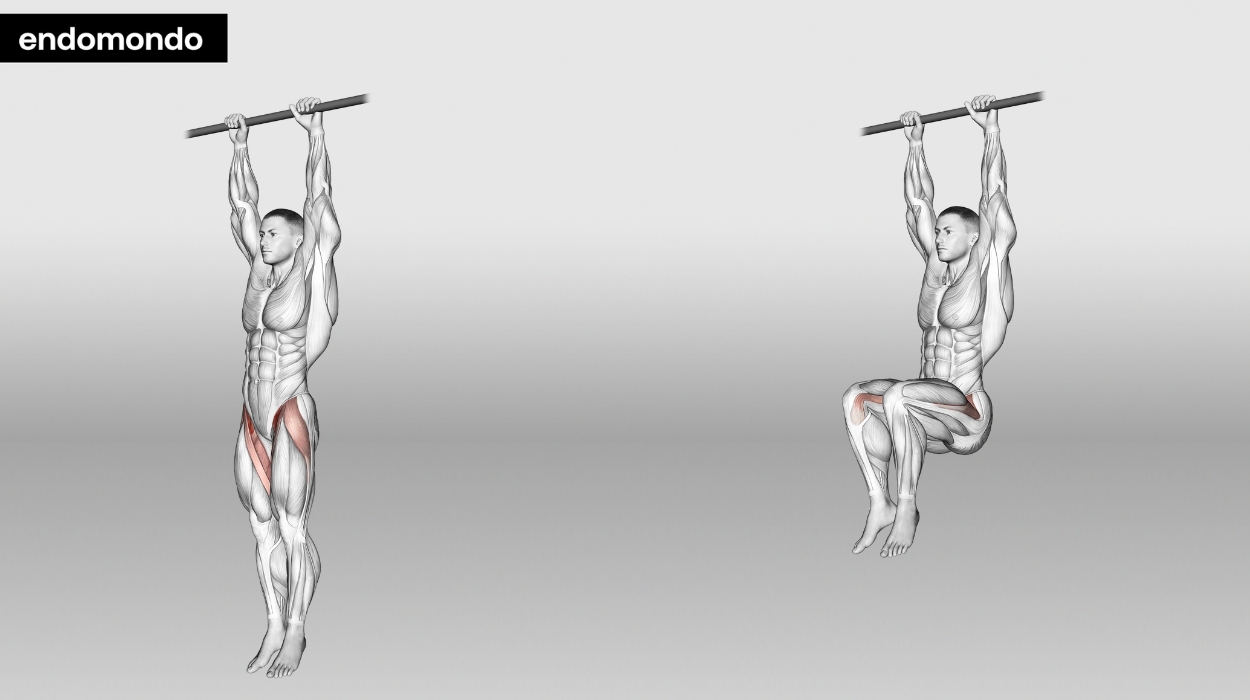
How to do:
- Hang yourself from a pull-up bar with fully extended arms and legs straight.
- Brace your core and lift your legs toward your chest by bending at the hips.
- With controlled movement, lower your legs back down to the starting position.
- Avoid swinging or using momentum so you focus on using the abs to lift and lower your legs.
Tips:
- Avoid swinging or using momentum to lift your legs.
- Raise your legs while keeping them straight and aim to bring them as close to a 90-degree angle with your torso as possible, squeezing your lower abs at the top.
- Maintain tension in your core throughout the exercise.
Optimal Sets and Reps: 3-4 sets of 10-15 reps.
Medicine Ball Slam
The medicine ball slam is a full-body movement. It is a dynamic compound ab exercise that targets multiple muscle groups while providing an intense cardiovascular workout. This explosive movement works your entire core and involves your shoulders, arms, and back, primarily engaging the rectus abdominis, obliques, and hip flexors, making it highly effective for core strength and development.
To perform the medicine ball slam, you lift a weighted medicine ball overhead and forcefully slam it onto the ground, involving your entire body in the motion. This movement not only helps sculpt a strong core but also improves power, endurance, and coordination. It’s an excellent choice for enhancing explosive strength, making it valuable for athletes and fitness enthusiasts alike. Additionally, this exercise helps release stress and boost your metabolism due to its high-intensity nature.
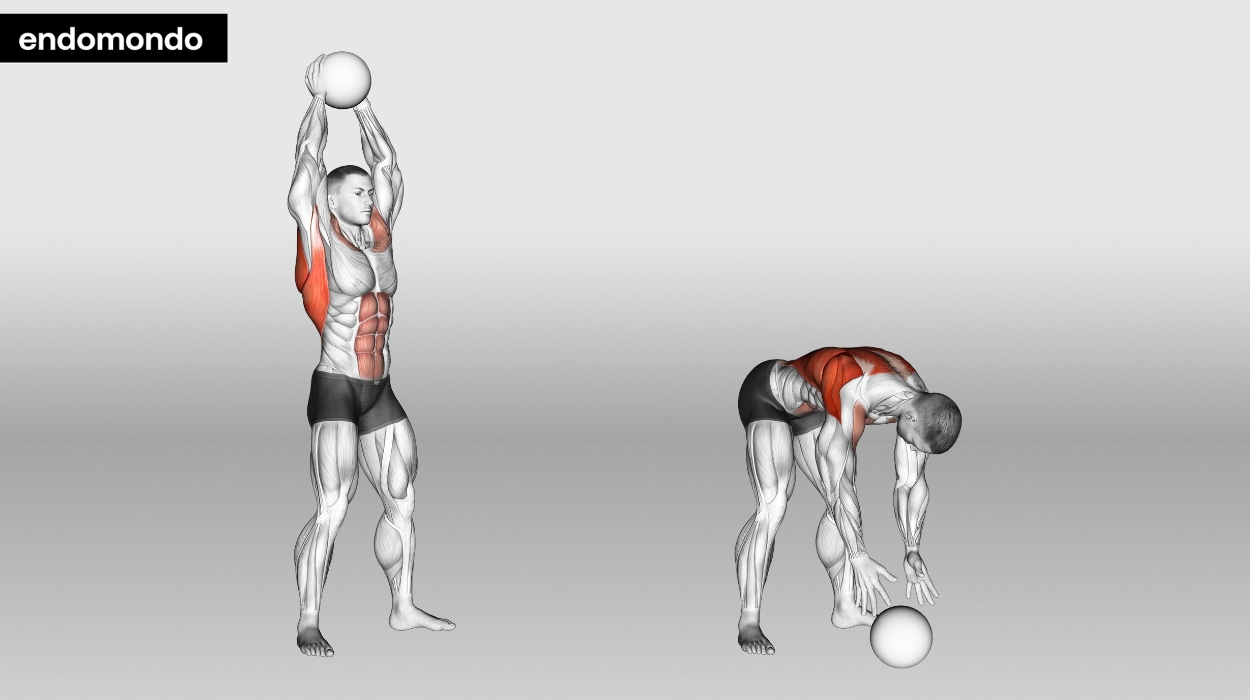
How to do:
- With feet shoulder-width apart, hold a medicine ball above your head.
- In a swift motion, slam the ball forcefully to the ground before you.
- Catch the ball on the bounce back and repeat the movement for the desired repetitions.
- Engage your core throughout the exercise and use your entire body to generate power.
Tips:
- Hinge at your hips while keeping your back straight to engage your core and prevent strain on your lower back.
- Use the power from your hips and core to generate force when slamming the ball, and make sure to follow through with your arms to avoid straining your shoulders.
- Maintain control of the ball as you catch it on the rebound, and aim to slam it with intensity for an effective full-body workout.
Optimal Sets and Reps: 3-4 sets of 12-15 reps.
Ab Wheel Rollout
This ab wheel exercise is superb for strengthening the entire upper body, including the abs, obliques, lower back, and shoulders. Ab wheel rollouts may be challenging initially, but they can help transform your body the more you make these dynamic ab moves.
This compound exercise not only works on your core strength but also engages the shoulders, chest, and back for stability. It is highly effective in building core endurance, enhancing posture, and reducing the risk of lower back pain. Additionally, the ab wheel rollout helps improve functional strength, making everyday activities easier and can contribute to a more toned midsection. It’s a versatile exercise that can be adapted to different fitness levels, making it suitable for both beginners and advanced athletes.
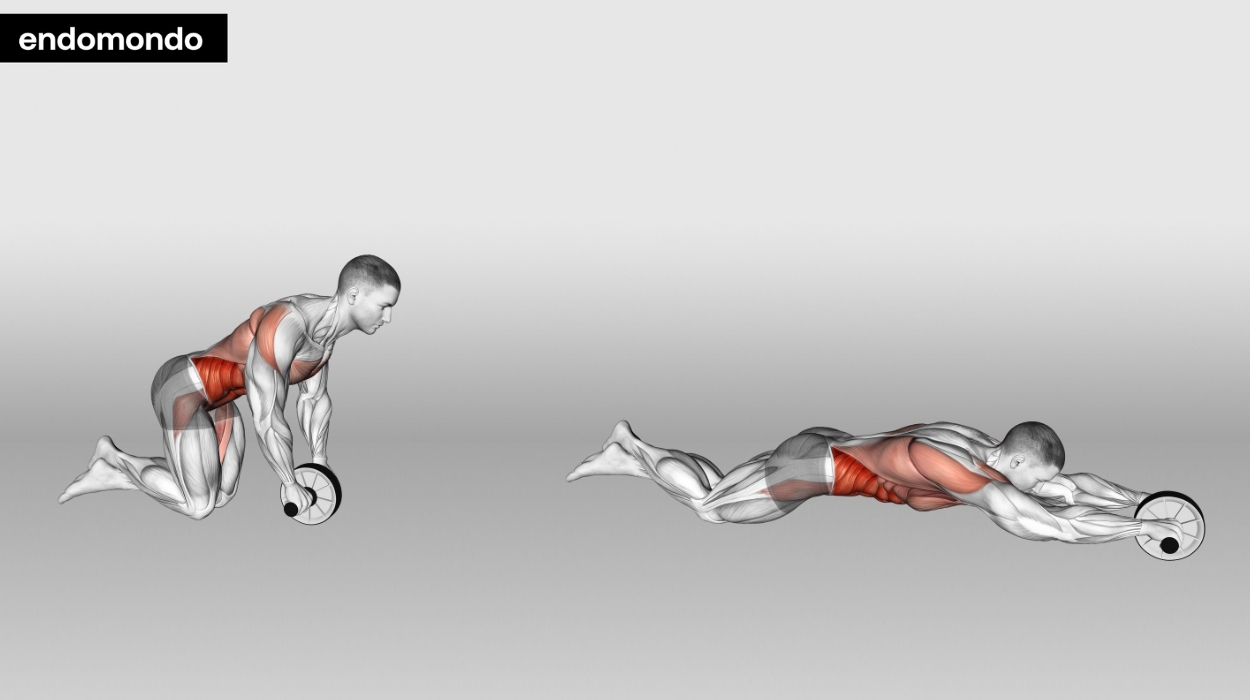
How to do:
- Start in a kneeling position with your hands gripping an ab wheel in front of you.
- With your core engaged and back straight, roll the wheel forward and extend your arms.
- Go as far as you can, maintaining control without arching your back. Try to keep your body a few inches above the floor.
- Brace your core and bring the wheel back to the starting position.
Tips:
- Keep your back straight and core engaged to avoid arching your lower back.
- Avoid relying on momentum to roll the wheel in and out. Instead, engage your core muscles to control the movement for maximum effectiveness and safety.
- Return to the starting position by using your core muscles to pull the wheel back, avoiding excessive arching of your back.
Optimal Sets and Reps: 3-4 sets of 10-12 reps.
Plank With Arm Raise
This exercise combines the traditional plank with an arm raise, adding an extra challenge to your core workout. This variation of the standard plank challenges your core stability and engages your back, shoulders, and upper arms.
This compound exercise not only strengthens your core muscles but also improves shoulder stability and enhances overall upper-body strength. It’s an excellent way to work on balance, coordination, and functional core strength, which can benefit daily activities and sports performance. The plank with arm raise is a versatile exercise suitable for various fitness levels, making it a valuable addition to any core-focused workout routine.
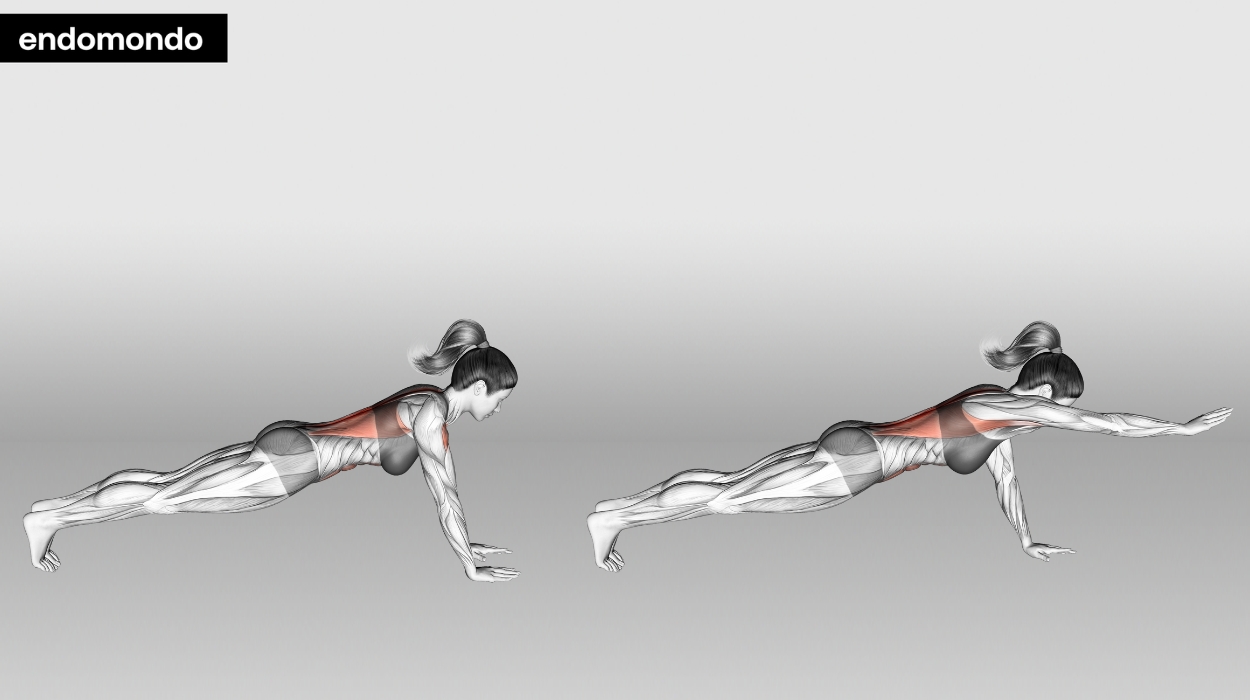
How to do:
- Begin in a low plank position on your elbows and toes, forming a straight line from head to heels.
- While engaging your core, lift one arm off the ground and raise it forward.
- Ensure you keep your back straight and avoid rotation in your hips or shoulders.
- Lower that arm back down and repeat on the other side.
Tips:
- Maintain a neutral spine and avoid arching your lower back, as this can strain your lower back and negate the core engagement.
- Lift your arm no higher than the shoulder level to prevent excessive strain on your shoulder joint and to maintain proper form.
- Focus on controlled breathing while holding the plank and raising your arms, aiming for stability and balance in each repetition.
Optimal Sets and Reps: 3-4 sets of 4-5 raises per arm.
Renegade Row
This fantastic full-body compound movement engages your abdominal muscles to stabilize your body and targets your back, shoulders, and arms.
This compound exercise not only helps to develop a strong and sculpted core but also enhances upper body strength, shoulder stability, and coordination. It’s an excellent choice for a full-body workout, providing both core strengthening and upper-body toning benefits. Incorporating renegade rows into your fitness routine can contribute to improved functional strength and overall fitness.
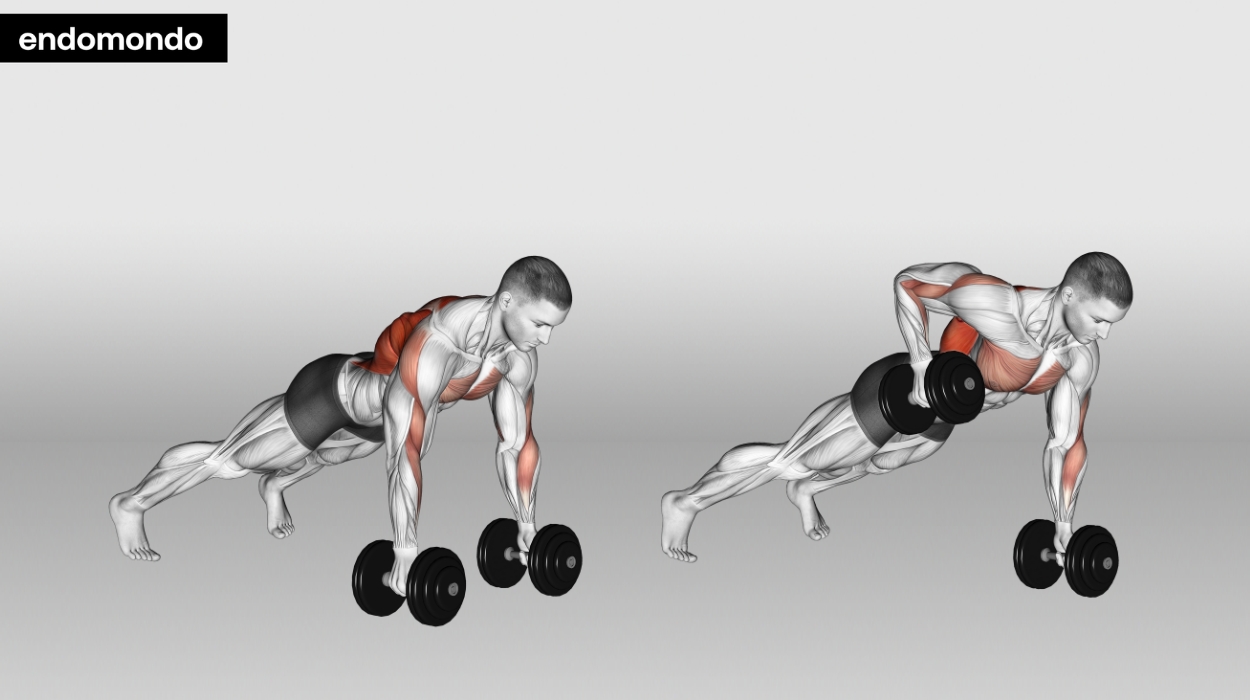
How to do:
- Start in a high plank position with your body in a straight line. Hold a dumbbell in each hand and keep your wrists in line with your shoulders.
- Keep your body stable and engage your core as you row one dumbbell up towards your chest, elbow close to your body.
- Lower the dumbbell back to the ground, then perform the row with the other arm.
- Alternate rows on each side while keeping your back straight in a strong plank position.
Tips:
- Ensure your hands are directly under your shoulders, and avoid placing them too far apart or too close together to maintain stability.
- Prevent swaying or twisting of your hips by bracing your core and stabilizing your pelvis throughout the movement.
- Pull the dumbbell or kettlebell towards your hip without shrugging your shoulders, emphasizing the contraction of your back muscles for a full range of motion.
Optimal Sets and Reps: 3-4 sets of 10-12 rows per arm.
Woodchopper
Woodchoppers involve twisting movements that mimic chopping wood. This compound exercise uses your obliques, rectus abdominis, transverse abdominis, shoulders, and back.
The woodchopper engages both the upper and lower abdominal muscles and is highly effective for developing core strength, stability, and rotational power. It also improves functional fitness, making daily activities easier and reducing the risk of injury. Adding this exercise to your workout routine can help you achieve a well-rounded and strong core, enhancing your overall athleticism and posture.
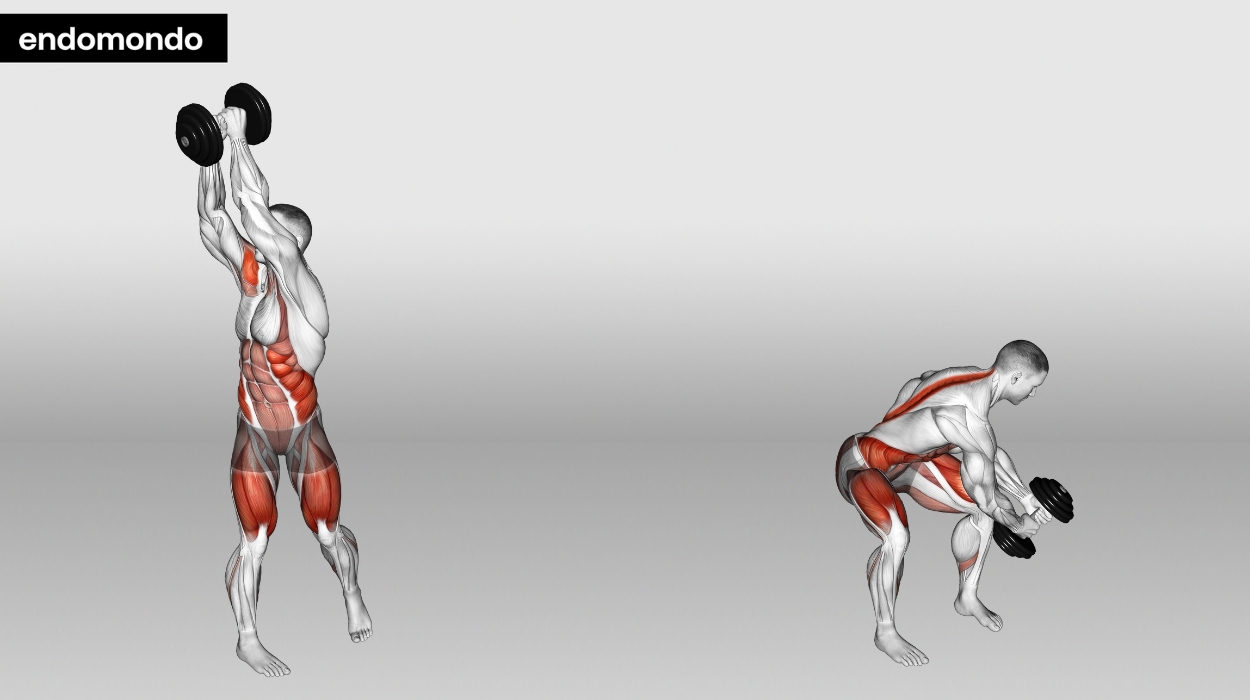
How to do:
- With your feet shoulder-width apart, hold a dumbbell or medicine ball with both hands at chest height.
- Rotate your torso to the right while bringing the weight diagonally up and across your body.
- As you bend your knees, swing the dumbbell or medicine ball down to the other side like chopping wood.
- Engage your core and use your obliques to swing the weight back up to the starting upright position.
- Perform the wood choppers on the right side for a set number of reps before switching to the left side.
Tips:
- Ensure your knees are slightly bent and your back remains straight to prevent injury.
- Begin with a manageable weight to master the technique, then gradually increase resistance as your strength improves to build muscle effectively.
- Exhale as you lift the weight and inhale as you return to the starting position.
Optimal Sets and Reps: 3-4 sets of 12-15 reps.
Single-Arm Kettlebell Swing
While the kettlebell swing is primarily a lower-body exercise, it also requires core stabilization and rotation. It targets multiple muscle groups like the core, glutes, and shoulders.
This exercise not only strengthens your core muscles but also improves your overall stability, balance, and functional strength. It engages your entire body and can help enhance your athletic performance while promoting fat loss and toning in the abdominal area.
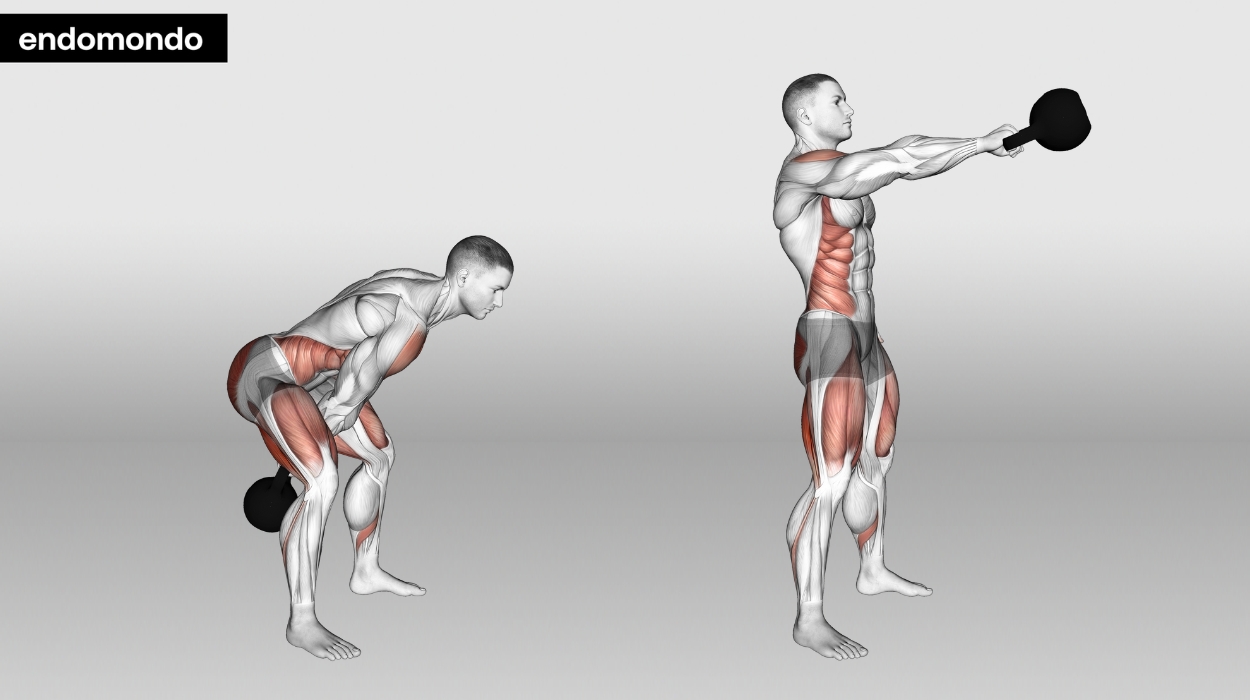
How to do:
- Stand with your feet slightly wider than hip-width and toes pointed slightly out.
- Hold the kettlebell with one hand and hang it down between your legs.
- Hinge at the hips and swing your kettlebell forward.
- Use the power from your hips to swing the kettlebell to chest height.
- Lower the kettlebell back down and repeat on the other side.
Tips:
- Initiate the movement by hinging at your hips, not bending at your knees.
- Maintain a straight back and use the power generated from your hips to swing the kettlebell.
- Choose a kettlebell weight that allows you to maintain proper form and control throughout the exercise.
Optimal Sets and Reps: 3-4 sets of 12-15 reps per arm.
Benefits Of Compound Ab Exercises
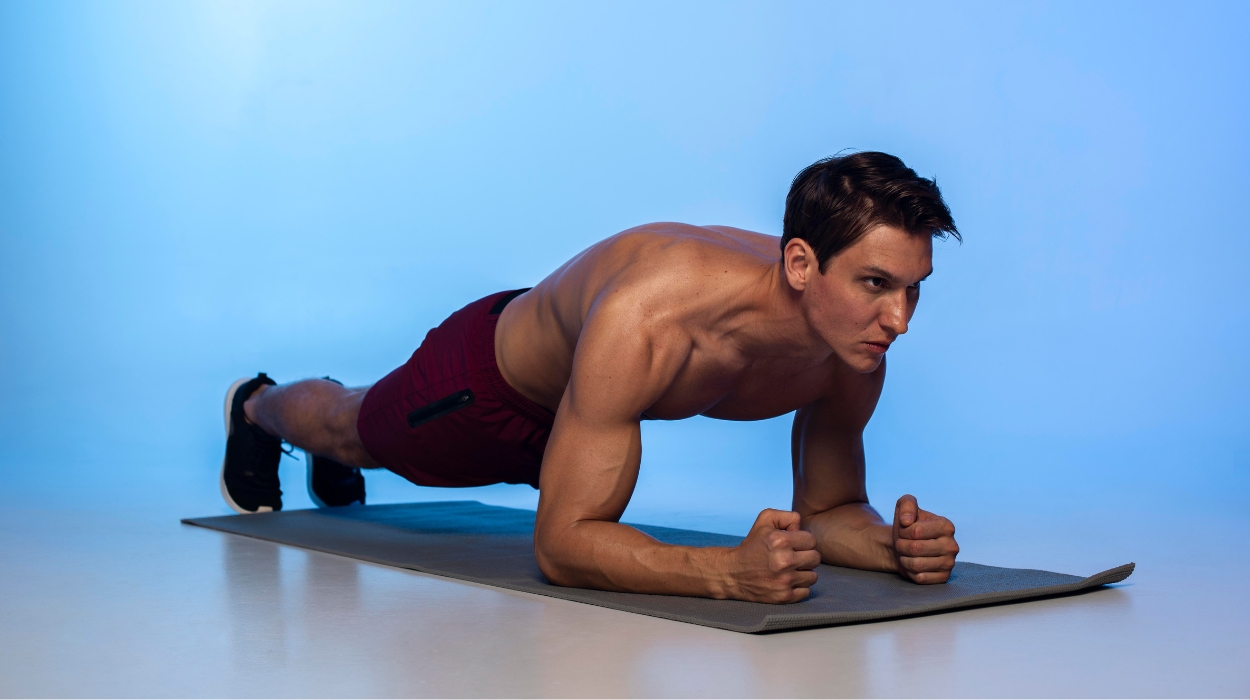
Compound ab exercises have many benefits that go beyond chiseled abs. Here are some key advantages to having a stronger core:
- Improves core strength and stability — By targeting the deep muscles of your core, compound exercises help develop a strong and stable foundation.[1] This helps improve your overall strength and balance.
- Improves cardiovascular fitness and VO2 max[2] — Your VO2 max is your body’s ability to utilize oxygen during exercise. Compound movements work multiple muscle groups simultaneously. These exercises increase how much oxygen your body is using and force your cardiovascular system to supply more oxygen-rich blood to your muscles.
- Enhances functional fitness[3] — These exercises mimic real-life movements. Functional fitness can help develop more core strength and stability. This not only benefits daily tasks, but it can help improve performance in sports and endurance activities too.
- Boosts calorie burn and fat loss — Compound exercises are usually higher-intensity and engage multiple muscle groups at once. This takes your ab workout to the next level by increasing your heart rate and boosting the calorie burn, resulting in improved body composition.[4]
- Enhances posture and reduces lower back pain — Strengthening the muscles around your spine helps stabilize the core, improve posture, and reduce lower back pain.[5]
Things To Consider
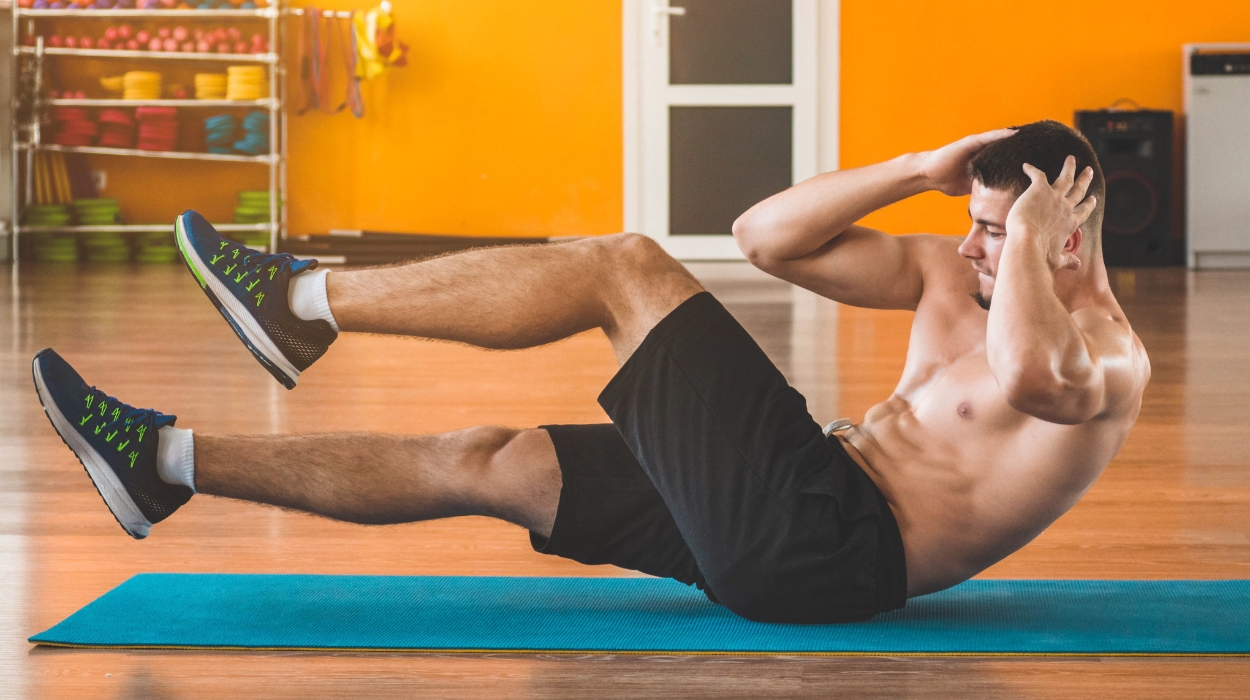
Compound ab exercises maximize a core workout by engaging multiple muscle groups at the same time. However, ensuring safety is crucial. Here are a few tips to remember while strengthening your core:
- Use the proper form — Maintaining correct form throughout each exercise helps to target the muscles you aim for effectively and reduces the risk of injury.
- Engage the core — Focus on engaging your core muscles throughout each exercise. This ensures proper spine stability while focusing on the muscles deep in your core.
- Focus on breathing — Pay attention to how you breathe throughout each rep. Be sure to exhale during the exertion phase and inhale during the relaxation phase of each movement.
- Progress gradually— Start with exercises that match your current fitness level and gradually increase intensity, resistance, or repetitions as your core strength improves. Progressing too fast can lead to excess stress on your muscles and injury.
- Warm-up — Always warm up before beginning your compound ab workout to increase blood flow and flexibility. This helps reduce muscle strain and discomfort.
- Utilize proper rest and recovery — Allow your core muscles adequate time to recover between workout sessions to prevent overuse injuries and support muscle mass growth. Aim to complete compound ab exercises 2-3 times a week.
- Use multiple forms of fitness — Incorporate compound ab exercises into a fitness routine that includes strength training, cardio, and flexibility exercises. This engages each muscle group to help improve overall fitness.
- Listen to your body — Pay attention to any discomfort or pain during exercises. Don’t push through intense pain, as it may indicate an injury. Modify or stop the movement if the pain continues or becomes more intense.
- Seek professional guidance — If you’re new to compound ab exercises or have specific health concerns, consider consulting a certified personal trainer. They can give guidance or create a personalized workout plan to fit your needs.
Conclusion
Focusing separately on upper abs workouts and lower abs workouts is an option. But, with this list of the best compound ab exercises, you can get a 6-pack faster.
Incorporating compound ab exercises and quality supplements into your fitness routine may dramatically help build more muscle and improve weight loss. Using the right exercises and proper nutrients can ensure you get the most from your compound ab exercises and fitness routine.
Frequently Asked Questions
Yes, compound exercises can burn belly fat. They engage multiple muscle groups, elevate heart rate, and increase calorie burn, contributing to overall fat loss, including in the abdominal area.
While compound exercises are highly effective, incorporating a variety of workouts ensures a well-rounded fitness routine and targets different muscle groups for optimal results.
Here are seven of the best compound ab exercises for a 6-pack:
1. Hanging leg raises.
2. Medicine ball slams.
3. Ab wheel roll-out
4. Plank with arm raises.
5. Renegade rows.
6. Woodchoppers.
7. Single-Arm Kettlebell Swing.
It depends on your fitness level and goals. However, some fitness professionals recommend between two to four compound exercises per workout when you are starting out.
Resources
- Hsu, S.-L., Oda, H., Saya Shirahata, Watanabe, M. and Sasaki, M. (2018). Effects of core strength training on core stability. Journal of Physical Therapy Science, [online] 30(8), pp.1014–1018. doi:https://doi.org/10.1589/jpts.30.1014.
- Paoli, A., Gentil, P., Moro, T., Marcolin, G. and Bianco, A. (2017). Resistance Training with Single vs. Multi-joint Exercises at Equal Total Load Volume: Effects on Body Composition, Cardiorespiratory Fitness, and Muscle Strength. Frontiers in Physiology, [online] 8. doi:https://doi.org/10.3389/fphys.2017.01105.
- Sajad Bagherian, Khodayar Ghasempoor, Rahnama, N. and Wikstrom, E.A. (2018). The Effect of Core Stability Training on Functional Movement Patterns in Collegiate Athletes. [online] ResearchGate. Available at: https://www.researchgate.net/publication/322973201_The_Effect_of_Core_Stability_Training_on_Functional_Movement_Patterns_in_Collegiate_Athletes.
- Hwang-Bo Kak, Cho, S.-H., Lee, Y.-H., Cho, B.-J., Kim, J.-W., Oh, B.-D. and Koh, H.-W. (2013). A Study of Effect of the Compound Physical Activity Therapy on Muscular Strength in Obese Women. Journal of Physical Therapy Science, [online] 25(8), pp.1039–1041. doi:https://doi.org/10.1589/jpts.25.1039.
- Chang, W.-D., Lin, H.-Y. and Lai, P.-T. (2015). Core strength training for patients with chronic low back pain. Journal of Physical Therapy Science, [online] 27(3), pp.619–622. doi:https://doi.org/10.1589/jpts.27.619.




